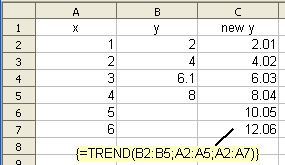Difference between revisions of "Documentation/How Tos/Calc: TREND function"
From Apache OpenOffice Wiki
< Documentation | How Tos
OOoWikiBot (Talk | contribs) m (Robot: Automated text replacement %s) |
|||
| Line 10: | Line 10: | ||
: If <tt>'''type'''</tt> is <tt>'''0'''</tt> the straight line found will pass through the origin; if <tt>'''type'''</tt> is non-zero or omitted the best fit straight line will be found. | : If <tt>'''type'''</tt> is <tt>'''0'''</tt> the straight line found will pass through the origin; if <tt>'''type'''</tt> is non-zero or omitted the best fit straight line will be found. | ||
| − | : <tt>'''TREND'''</tt> returns an array of the y values of the straight line found, corresponding to the x values in <tt>'''new_xvalues'''</tt> (or if omitted <tt>'''xvalues'''</tt>). It must be entered as an | + | : <tt>'''TREND'''</tt> returns an array of the y values of the straight line found, corresponding to the x values in <tt>'''new_xvalues'''</tt> (or if omitted <tt>'''xvalues'''</tt>). It must be entered as an [[Documentation/How_Tos/Using Arrays|array formula]] (for example by using '''Cntrl-Shift-Enter''' rather than just '''Enter'''). |
: <tt>'''yvalues'''</tt> and <tt>'''xvalues'''</tt> must be the same size. <tt>'''new_xvalues'''</tt> may have a different size. | : <tt>'''yvalues'''</tt> and <tt>'''xvalues'''</tt> must be the same size. <tt>'''new_xvalues'''</tt> may have a different size. | ||
| Line 25: | Line 25: | ||
* [[Documentation/How_Tos/Calc: SLOPE function|SLOPE]], | * [[Documentation/How_Tos/Calc: SLOPE function|SLOPE]], | ||
* [[Documentation/How_Tos/Calc: STEYX function|STEYX]] | * [[Documentation/How_Tos/Calc: STEYX function|STEYX]] | ||
| − | |||
* [[Documentation/How_Tos/Using Arrays|How To Use Arrays in Calc]] | * [[Documentation/How_Tos/Using Arrays|How To Use Arrays in Calc]] | ||
| − | |||
* [[Documentation/How_Tos/Calc: Array functions|Array functions]] | * [[Documentation/How_Tos/Calc: Array functions|Array functions]] | ||
| − | |||
* [[Documentation/How_Tos/Calc: Functions listed alphabetically|Functions listed alphabetically]] | * [[Documentation/How_Tos/Calc: Functions listed alphabetically|Functions listed alphabetically]] | ||
* [[Documentation/How_Tos/Calc: Functions listed by category|Functions listed by category]]}} | * [[Documentation/How_Tos/Calc: Functions listed by category|Functions listed by category]]}} | ||
Revision as of 14:36, 25 February 2009
TREND
Fits a straight line to data using linear regression and returns points on that line.
Syntax:
TREND(yvalues; xvalues; new_xvalues; type)
- yvalues and xvalues are single row or column ranges specifying points in a set of data.
- TREND fits a straight line through these data points, using the linear regression method.
- If type is 0 the straight line found will pass through the origin; if type is non-zero or omitted the best fit straight line will be found.
- TREND returns an array of the y values of the straight line found, corresponding to the x values in new_xvalues (or if omitted xvalues). It must be entered as an array formula (for example by using Cntrl-Shift-Enter rather than just Enter).
- yvalues and xvalues must be the same size. new_xvalues may have a different size.
Example:
=TREND(B2:B5; A2:A5; A2:A7)
- when entered as an array formula in cell C2, where the x values in A2:A7 are 1,2,3,4,5, 6 and the y values in B2:B4 are 2, 4, 6.1, 8 returns {2.01|4.02|6.03|8.04|10.05|12.06}. The data points are very nearly on the line y = 2x (and would be if B4 contained 6 instead of 6.1). The best fit line found is therefore very nearly y=2x.
- This example shows how TREND may be used to predict future values.
